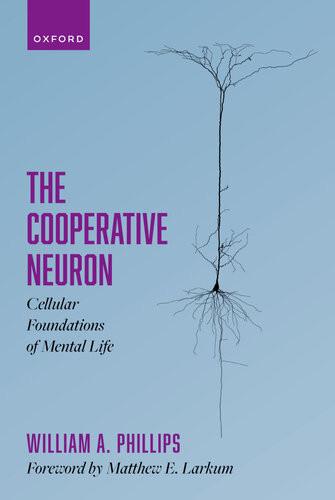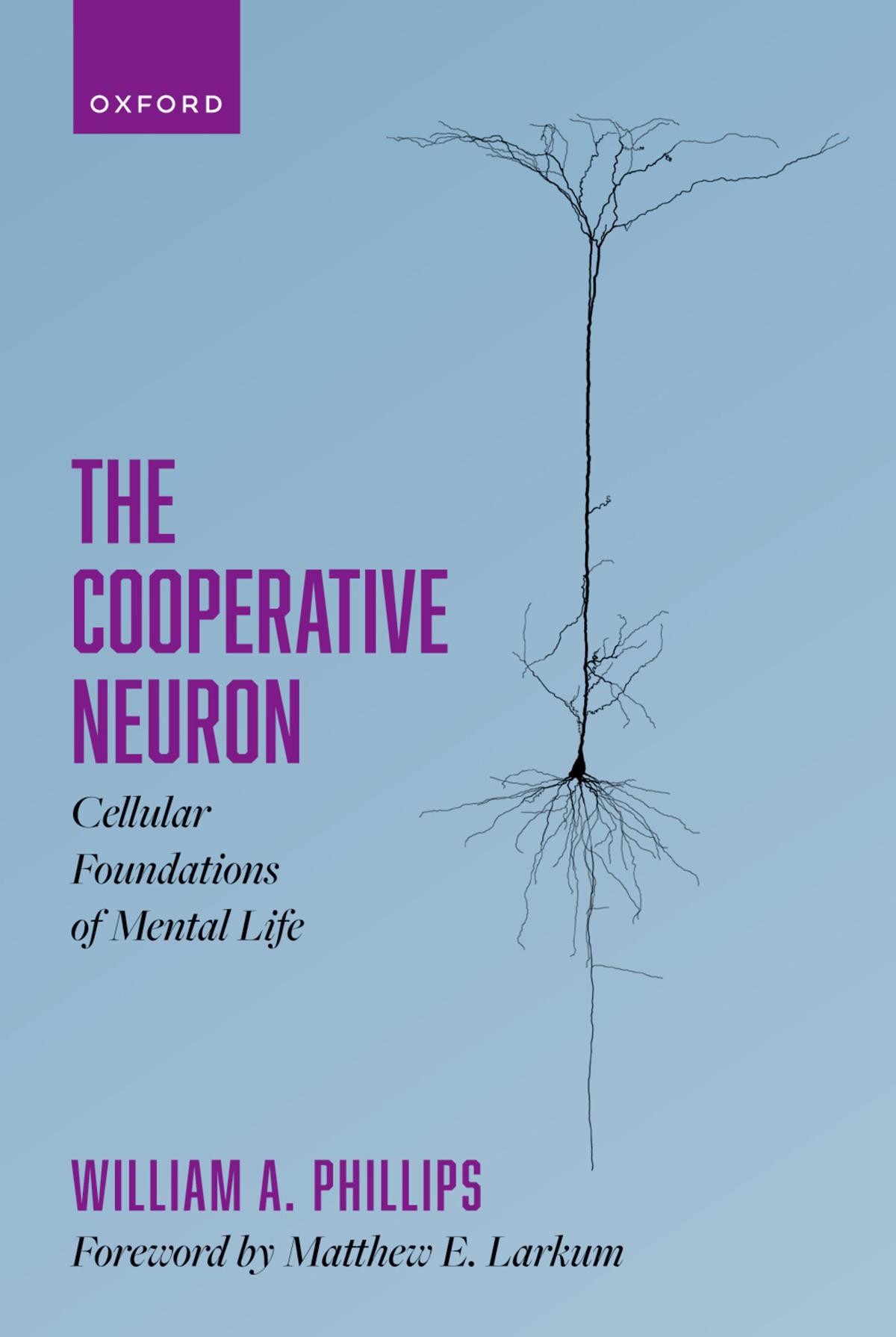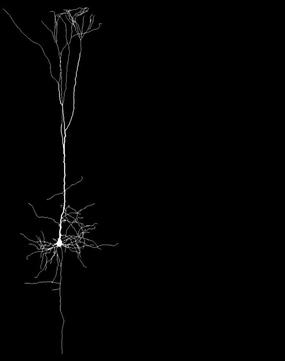The Cooperative Neuron
Cellular Foundations ofMentalLife
William A. Phillips
ForewordbyMatthewE.Larkum
Great Clarendon Street, Oxford, OX2 6DP, United Kingdom
Oxford University Press is a department of the University of Oxford. It furthers the University’s objective of excellence in research, scholarship, and education by publishing worldwide. Oxford is a registered trade mark of Oxford University Press in the UK and in certain other countries
© Oxford University Press 2023
The moral rights of the author have been asserted
First Edition published in 2023
All rights reserved. No part of this publication may be reproduced, stored in a retrieval system, or transmitted, in any form or by any means, without the prior permission in writing of Oxford University Press, or as expressly permitted by law, by licence or under terms agreed with the appropriate reprographics rights organization. Enquiries concerning reproduction outside the scope of the above should be sent to the Rights Department, Oxford University Press, at the address above
You must not circulate this work in any other form and you must impose this same condition on any acquirer
Published in the United States of America by Oxford University Press 198 Madison Avenue, New York, NY 10016, United States of America
British Library Cataloguing in Publication Data
Data available
Library of Congress Control Number: 2022949982
ISBN 978–0–19–887698–4
eISBN 978–0–19–887700–4
DOI: 10.1093/oso/9780198876984.001.0001
Oxford University Press makes no representation, express or implied, that the drug dosages in this book are correct. Readers must therefore always check the product information and clinical procedures with the most up-to-date published product information and data sheets provided by the manufacturers and the most recent codes of conduct and safety regulations. The authors and the publishers do not accept responsibility or legal liability for any errors in the text or for the misuse or misapplication of material in this work. Except where otherwise stated, drug dosages and recommendations are for the non-pregnant adult who is not breast-feeding
Links to third party websites are provided by Oxford in good faith and for information only. Oxford disclaims any responsibility for the materials contained in any third party website referenced in this work.
Tomywife,Rena
ourchildren,Fred,Lowana,andNed ourgrandchildren,Charlie,Thomas,Andrey,andDaniel andtoallgrandchildren,everywhere.
Foreword
The history of science is replete with unexpected turning points that needed someone to put their finger on the right way to construe the emerging data. More often than not, it involves some insight, change in perspective or even a paradigm shift, that allows the known facts to be reorganized in a way that makes them appear to fall suddenly into place. It is usually difficult to identify turning points as they happen even though they frequently appear obvious with the benefit of hindsight. This is often because of the sheer amount, and often sheer disorganization, of the data. The Copernican Revolution required the marriage of hard-fought observations with a change in perspective. Similarly, Darwin’s theory of Natural Selection made sense of a mountain disparate evidence with a fundamentally different starting assumption. In both these cases, and in numerous others throughout history, the critical insight itself is at first treated as improbable but eventually as obvious. I believe that The Cooperative Neuron has all the hallmarks of a perspective shift that will transform and endure in the best traditions of transformative science.
With this book, Bill Phillips attempts nothing less than to explain the relationship between the mind and brain, starting from bottomup principles. Make no mistake, ‘Here be dragons!’. There are many who would claim this is a foolhardy mission, both today and for the foreseeable future. Indeed, it is common to come across the opinion, including amongst neuroscientists, that, ‘if the brain were so simple that we could understand it, we would be so simple that we couldn’t’. So why should you expect this book to solve one of the last great mysteries of our time? And especially why should you invest the time and energy to embark on the trip Bill Phillips lays out from first neuroscience principles to psychophysics and information
theory? Well, one reason is that it’s fun all the way! Having spent time with Bill myself, I can attest to the fact that his enthusiasm is expressed in every bone and sinew. In this book, it pours out of the text. But the main reason is the multifaceted intellect he throws at this problem. This is truly a book that only Bill Phillips could have written.
Also in the best traditions, the key insight of this book requires the reader to take on a perspective shift that runs against the current dominant dogma. It requires the reader to stop assuming that neurons of the brain are simple counting devices, but instead to take their complexities seriously. For a reader with no neuroscience experience, this might seem trivial. Why shouldn’t neurons be complex? To be honest, I often find myself feeling a little bit like the little boy in the Emperor’s New Clothes story. I mean, they do look complex, after all. And having recorded from thousands of real neurons, I can attest that their properties turn out to be more complex than their appearance already suggests. Nevertheless, the dominant description of a neuron in most models of the brain and artificial neural networks is not much more than a blob that counts how many signals arrive, and if and when enough do arrive, sends the signal on to the next unsuspecting blobs. In case you’re tempted to say, ‘that’s absurd!’, just remember that using only this description (embedded in a deep neural network) your phone can recognize your face, the best chess players of all time can be totally embarrassed, and everyday texts can be translated and even generated de novo in the style of different famous authors such as Shakespeare and Edgar Allen Poe. So, ‘put that in your pipe and smoke it!’, says the current and apparently unstoppable juggernaut of neuroscience and artificial intelligence research.
But have no fear! Professor Bill Phillips of Stirling University has done the heavy lifting for you in the form of this book. This book is really the distillation of the important complexities of the important neurons of the brain cast in the important abstraction of what their importantfunction is. As you might guess from the title of the book, this involves the notion of the cooperative neuron. Having myself spent years interacting with Bill mulling over the morass of details
one could focus on in describing real neurons and their function, I can say that this analogy works like all good insights in that it irresistibly instils in you that ‘Aha!’ feeling. However, as the author himself warns early on, you should not let yourself be satisfied with the first ‘Aha!’. Rather, I would advise you to enjoy the various ways in which the cooperative neuron perspective solves one neuroscience problem after another as you progress through the book. Unless you’re Bill Phillips or some other rare polymath, this is going to involve going to places you haven’t yet thought about.
This book, therefore, introduces a kind of fiction in the best possible sense—the notion of the Cooperative Neuron. As Yuval Noah Harari points out in 21 Lessons for the twenty-first century, ‘For better or worse, fiction is among the most effective tools in humanity’s tool kit. By bringing people together, religious creeds make large-scale human cooperation possible. They inspire people to build hospitals, schools, and bridges in addition to armies and prisons. Adam and Eve never existed, but Chartres Cathedral is still beautiful’. He might have added that fiction is a great tool in the scientist’s tool kit too. A simultaneously dangerous but powerful tool, so use the TheCooperativeNeuronwisely!
Matthew Larkum Berlin 2022
Preface
This book describes and contributes to a revolution that is occurring in brain and mind sciences. Twentieth-century psychology and systems neuroscience assumed that, in general, neurons sum all their synaptic inputs and signal the extent to which that exceeds a threshold. In contrast to that assumption, recent discoveries show that many neurons in the mammalian brain have two functionally distinct sets of inputs: one that provides the inputs about which the neuron usually transmits information, and one that amplifies that transmission when it is useful to do so in the context of information being transmitted by other neurons. This form of context-sensitive information processing is cooperative in that it seeks agreement between the active neurons, thus reducing mental conflict. This cooperative context-sensitivity provides cellular foundations for basic cognitive capabilities, so they have fundamental implications that are transforming our understanding of relations between mind and brain.
These discoveries use the Nobel-prize winning techniques of patch-clamping to explore processes of communication within individual neurons. They find that a special class of the pyramidal neurons that are widely distributed throughout the mammalian neocortex can do more than psychologists and systems neuroscientists have long assumed to be possible for any neuron. That is, they can use one subset of their inputs as a context within which to amplify transmission of information about their other inputs when that increases the coherence and usefulness of the system’s overall activity.
The discovery of pyramidal neurons with context-sensitivity has fundamental implications for neuroscience. It casts new light on the systems level of organization, on intracellular communication, on the
functions of ion channels in the cell’s dendrites, and on the genes that either code for them or regulate their expression. Even more importantly, it has profound implications for psychology, neurology, psychiatry, and philosophy. This book shows that cellular contextsensitivity provides foundations for perceptual disambiguation, selective attention, working memory and imagery, emotional prioritization, cognitive control, and learning.
The book sketches evidence of evolutionary, developmental, and pathological variations in cellular context-sensitivity, and emphasizes the strong support this provides for the neuroconstructivist view of cognitive development. As these context-sensitive cellular mechanisms can malfunction in various ways, the book discusses these effect as they related to several pathologies, including epilepsy, psychosis, autism, and other neurodevelopmental disorders and helps explain what those disorders have in common and why there is such diversity both within and between them. As expected of findings with such widespread significance, these discoveries cast new light on enduring philosophical issues. They also provide cellular foundations for the theory of predictive processing within epistemology, for the selectivity of conscious experience, and for morality as cooperation.
This is the first book to argue for the fundamental importance of this new field of research. It is written for philosophers, psychologists, psychiatrists, and psychopathologists interested in the neural bases of mind, as well as for neuroscientists, neurologists, and anaesthetists interested in the philosophical and psychological significance of their work. It aims to make the neuroscience intelligible to psychologists, the psychology intelligible to neuroscientists and clinicians, and both fields intelligible to philosophers interested in relations between mind and brain. Finally, there are good grounds for supposing that it could also be of use to computer scientists who are developing machine learning algorithms inspired by neuroscience.
We are in the early days of this revolution in our understanding of the cellular foundations of mental life, however, so the discoveries on which this book is based will be unfamiliar to most people, including
many neuroscientists, psychologists, and clinicians. Many of them are still committed to the assumption that neurons in general operate as simple integrate-and-fire point processors, and Chapters 3, 4, and 5 provide evidence for this newly emerging concept. Consequently, those chapters discuss complex esoteric issues, so each has a final summary of its contribution to the story overall. The first and last chapters summarize the essence of the perspective advocated.
The intellectual journey leading to this book was long and depended on essential contributions from a wide range of disciplines. It began in 1959 when I was an undergraduate student in the physics department of Manchester University where Ernest Rutherford had first split the atom in 1917. After just one year I switched to the study of psychology to pursue the answer to the central question that enthralled me as a young teenager (as it still does): how can minds be brains? I had, and still have, no doubt that the brains from which minds arise are composed of the matter whose properties have been revealed by physics and chemistry.
In switching from physics to psychology I took two key aspects of the physics mindset with me. First, I assume that what science seeks is a single coherent understanding of all we know. No part of that understanding can be a ghetto or island of knowledge entirely unto itself. Second, successes in that scientific search are likely to reveal realities that not only transcend what we knew already, but also, in some crucial ways, directly contradict what we thought we knew. Despite its many wonders, twentieth-century psychology is deeply unsatisfactory from that point of view. Few, if any, of its basic concepts are rooted in the cellular physiology and biophysics of the neurons that perform the information-processing operations inferred from psychological investigation. The conceptual framework outlined in this book aims to root basic psychological processes in their cellular foundations. It shows in partial, but considerable, detail how richly and deeply basic psychological processes are rooted in cellular processes, and especially in those of context-sensitive pyramidal cells.
A great deal of good fortune has been essential to making my intellectual journey possible. In addition to having had a long and healthy life with unwavering family support in a peaceful house and garden in the Scottish hills, I have had the great good fortune to meet and interact closely with many eminent world authorities in each of the disciplines on which our understanding of the cellular foundations of mental life depends. That good fortune began in 1966 when, as a PhD research student, I was part of a small seminar in the Australian National University in which eminent philosopher and member of the Vienna Circle Herbert Fiegl crossed swords with neurophysiologist and Nobel Prize-winner John Eccles. Their disagreement concerned free will, on which Eccles’ views were largely formed by his Catholic faith. It seemed clear to me that, although Eccles knew far more about the brain, Fiegl was correct in insisting that the questions concerning free will were not only unresolved, but also not even adequately posed.
Now that we are developing a better understanding of the cellular foundations of mental life, we are more able to pose this issue in a form that can be explicitly related to brain function. I first became convinced that those foundations include cooperative contextsensitivity when I saw how that intuition can be made mathematically precise using the concept of three-way mutual information. That was about 30 years ago. Statistician Jim Kay, with his expert knowledge of information theory and neural networks, immediately saw the force of that intuition. Since then, he and I have worked closely together to improve and publicise it. Many eminent experts have now contributed to that goal by commenting on this book and suggesting corrections or improvements. In addition to Matthew Larkum, whose work is of central importance to this book, they include neuroscientists Javier DeFelipe, Albert Gidon, Peter König, Bjorn Merker, Danko Nikolić, David Nutt, Jan Schulz, Matthew Self, Gordon M. Shepherd, Gordon M. G. Shepherd, Stewart Shipp, Johan Storm, and Mototaka Suzuki; psychologists Jaan Aru, Victor Almeida, Talis Bachmann, Alan Baddeley, Peter Cahusac, Trevor Harley, David Heeger, Graham Hitch, Lotta Upanne, and Ivo Vlaev; cognitive neuroscientists Karl Friston, Lars Muckli, Lucy Petro,
Viola Priesemann, Mac Shine, and Michael Wibral; neurologists and psychopathologists Kevin Bender, Chris Frith, Uta Frith, Alberto Granato, Avram Holmes, and Steve Silverstein; philosophers Andy Clark, Tomas Marvan, and Michal Polak; and computational neuroscientists Bruce Graham, Adam Linson, Tuomo Mäki-Marttunen, Verónica Mäki-Marttunen, Heiko Neumann, Leslie Smith, and Mike Spratling. Much support and encouragement has also been given by psychologists at the University of Stirling during my five decades there, and especially by Christine Caldwell, Ben Craven, Ben Dering, Martin Doherty, Peter Hancock, and Jan Kuipers.
An acid test of any conception of how brains work is whether it can be used to design algorithms that do useful things when applied to big real-world data. Ahsan Adeel has made a major contribution by showing that our conception of cooperative context-sensitive computation passes that acid test. From a long friendship with eminent logician and teacher of mindfulness Henk Barendregt, I have acquired a view of mental life that has shaped my attitude to many of the issues with which the book is concerned. Martin Baum and Jade Dixon at Oxford University Press, together with the copyeditor Michele Marietta, provided much needed encouragement and helped transform the raw draft into its final form.
Finally, this book, and the decades of work leading to it, would not have been possible without the unflagging support and patience of my wife, Rena. In addition to running daily life throughout our more than 60 years together, she has patiently listened to my perpetual musings about brain and mind. Her keen social insights have kept me, and the book, in touch with everyday reality.
Bill Phillips University of Stirling August 2022
Contents
Introduction to TheCooperativeNeuron
1. Life, Brain, and Mind: Marvels of Cooperation between Diverse Individuals
Enduring Philosophical and Psychological Issues Can Now be Explicitly Related to the Cellular Foundations of Mind
Information-processing Operations Can be Distinguished from Information Content, and Both Can be Studied by Psychological and Neurobiological Methods
Amplification of Pyramidal Cell Output if Relevant in the Current Context
Clarification of Some Contentious and Ambiguous Terms
Cellular Psychology Is Analogous to Molecular Biology
Mental Life Is Not Behaviour
Notes
2. Cerebral Neocortex: Hierarchies of Abstraction in Physical Matter that Knows and Doubts, Thinks and Feels, Intends and Hopes
Function Depends on Structure
The Neocortex: A Vast Number of Neurons
The Neocortical Sheet: Six Layers, not Three
The Regions of the Neocortex
Organization of Neocortical Regions into Hierarchies of Abstraction
Neurobiological and Psychological Evidence for Common Neocortical Information Processing Operations
Notes
3. Neocortical Pyramidal Cells that Cooperate by Sensitivity to Context
Common but Misleading Assumptions about the Cellular Bases of Mind
Pyramidal Cells as Leaky Integrate-and-Fire Point Neurons
Context-sensitive Two-point Neurons
On the Diversity of Pyramidal Cells
Inhibition and Disinhibition of Apical Function
Research on Cooperative Context-sensitivity Is in Its Infancy
Summary and Rapid Growth of This Research Field
Notes
4. Cooperative Neurons in Various States of Mind and Brain
States of Wakefulness and States of Sleep
Modulatory Neurotransmitters Regulate Transitions between Mental States
Neuromodulators Regulate Mental State by Modifying Apical Function
Three Modes of Apical Function: Amplification, Drive, and Isolation
General Anaesthetics Interfere with Apical Function
Mental State and Conceptions of Consciousness
Summary
Notes
5. What Cooperative Neurons Do for Mental Life
The Coordination of Mental Processes Depends on Cooperative Context-sensitivity
Context Guides Perception via Apical Dendrites
Conscious Experience
Selective Attention
Working Memory and Imagery
Prioritization of Emotionally Charged Events
Cognitive Control
Learning and Long-term Memory
Summary
Notes
6. Evolution and Development of Cooperative Neurons
Evolution of Cooperative Neurons
Evolution of Cognitive Capabilities That Depend on Cooperative Context-sensitivity
Development of Apical Structure and Physiology
Cooperative Context-sensitivity: A Key Role in Cognitive Development
Language and Thought
Notes
7. Pathologies of Cooperative Neuronal Processing
Epileptic Loss or Impairment of Consciousness
Schizophrenia Spectrum Disorders
Anti-NMDA Autoimmune Encephalitis
Autism Spectrum Disorders
Foetal Alcohol Spectrum Disorders
Notes
8. An Information-theoretic View of Context-sensitive Computation
Distinguishing Abstract Theories from Detailed Models
Information Theory: A Formal Perspective on Contextsensitive Computation
Coherent Infomax: A Theory of Local Processors with Receptive and Contextual Fields
Decomposition of Transmitted Information
Transmitted Information Decomposition Quantifies
Context-sensitive Computation
Transmitted Information Decomposition Quantifies
Objectives of Context-sensitive Learning
The Neurobiology of Cooperative Context-sensitive Computation Inspires Effective and Efficient Machine
Learning Algorithms
Notes
9. Difficulties and Unresolved Issues
Cellular Psychology Is in Its Infancy So Many Issues Are Unresolved
How Cooperative Context-sensitive Computation Relates to Free Energy Reduction and Predictive Coding How Cooperative Neurons Are Embedded in Cortical Microcircuits
How Cooperative Neurons Are Regulated by the Neuromodulators
How Cooperative Neurons Relate to the Speed of Thought How Cooperative Neurons Relate to Hobson’s and Freud’s Views on Dreams
Are There Distinctively Human Forms of Cooperative Context-sensitive Computation? Are There Regional and Developmental Variations in Cooperative Context-sensitivity?
Technological Potential of Cooperative Context-sensitive Computation
Notes
10. Mind’s Place in Nature
Knowledge and Doubt Self-identity
Life’s Purposes
Notes
ListofAbbreviations
Bibliography Index
Introduction to The Cooperative Neuron
A new era is dawning in the sciences of mind and brain. This book provides an overview of a conceptual revolution that is occurring in our understanding of the cellular foundations of mental life and its disorders. It relates conscious perception, thought, and action to recently discovered capabilities of pyramidal cells, a special class of neocortical neuron that has long been known to be widely distributed through the cerebral neocortex. The book describes in detail how many, though not all, of those cells are sensitive to context. Though this cellular context-sensitivity involves complex events that are unfamiliar to many neuroscientists and to most psychologists, the conceptual revolution to which these discoveries lead is, in essence, simple. It is now known that many pyramidal neurons in the neocortex have two functionally distinct sets of input: one provides the input about which the neuron usually transmits information, and the other can selectively amplify that transmission when it is useful to do so in the context of information being transmitted by other neurons. This form of context-sensitive information processing is cooperative in that it seeks agreement between the active neurons, thus reducing mental conflict. It provides cellular mechanisms that simplify the production of coherent percepts, thoughts, and actions that are usefully related to current goals and long-term needs. Selective amplification of the information that is currently relevant becomes both more difficult and more crucial as the information carrying capacity of a system’s sensors, memory, needs, and effectors increases.
Discovery of this selective amplification is a fundamental advance in the field of neuroscience because it shows that some neurons can do more than was assumed possible for neurons in general. Twentieth-century systems neuroscience and psychology were
largely based on the assumption that neurons operate as integrateand-fire point processors. In other words, it was widely assumed that neurons in general sum all their many excitatory and inhibitory synaptic inputs to compute a net amount of excitation about which their outputs then transmit information. That summing of all synaptic inputs in a way that is the same across all dendrites has been memorably described as constituting a ‘dendritic democracy’. That description has been shown to have empirical validity in the case of neurons in hippocampal regions, which are a small (but much studied) part of the forebrain.
Pyramidal neurons in the neocortex are far more numerous and far more discerning than hippocampal neurons, however. Many of them can use one subset of their inputs to decide when the information that they transmit is currently relevant in the context of the system’s overall activity. Neural systems containing that special class of neuron can operate with greater flexibility. When vital aspects of organism’s environment change its chances of survival and success depend on the flexibility with which it can act in new ways when presented those new circumstances. Unfortunately, though often used in psychology and neuroscience, the notion of flexibility is rarely adequately defined. This book interprets it as implying activity that is adapted to the context within which it occurs. Cellular context-sensitivity increases the effectiveness and efficiency with which new actions can be generated in new situations, reduces the transmission of large amounts of information when it is currently irrelevant, facilitates discovery of the information that is relevant at higher levels of abstraction, and makes learning easier by helping to separate the information to be learned from a mass of background activity that would otherwise be a noisy nuisance. Thus, it increases the coherence, adaptability, and usefulness of the organism’s overall activity.
The evidence for a special class of neurons that have two functionally distinct sites of integration, one of which can provide a context for responding to inputs to the other site, provides a new perspective from which to reinterpret many basic phenomena in
psychology and cognitive neuroscience, and from which to discover new phenomena.
This broadly conceived field of research is growing rapidly, but is already substantial, as shown in later chapters. It can be called ‘cellular psychology’ where that phrase is used by analogy to the phrase ‘molecular biology’, the field of biological research that discovered how the aperiodic crystals DNA and RNA convey a vast amount of information from parent to child. That discovery showed that DNA and RNA molecules can do far more than was previously thought possible for molecules in general. Similarly, discovery of a large class of neocortical neurons that have exceptional capabilities for cooperating shows that those neurons can do far more than was previously thought possible for neurons in general. They are exceptionally good at cooperating, and that capability may be the root of the special magic of the mammalian neocortex, explaining why it has expanded and diversified so greatly during mammalian evolution, and how it set the scene for the evolution of the human intellect and the subsequent revolutions in human history.
This introduction summarizes the main topics discussed and inferences drawn in each of the book’s ten chapters. It alerts the reader to some of the underlying assumptions on which those inferences are based. The evidence reviewed and arguments presented in this book are accompanied by a deep undercurrent of moral concern. It is sometimes claimed, or implied, that science shows nature to be pointless and life to be selfish. In contrast to that, I see progressive aspects of the history of nature as giving it direction and I see living things as marvels of cooperation. So, readers should not be surprised if they detect a bias toward that more positive view in the story that I tell.
Chapter 1 briefly outlines the discovery of neurons that are especially good at cooperating. It explains how these neurons are sensitive to the current context and can use that sensitivity to modify the strength of their output in ways that increase the coherence and usefulness of the system’s overall activity. It also outlines further assumptions guiding the perspective presented in this book. Chapter 2 provides a brief description of the gross
anatomy and functions of the mammalian thalamocortical system, which is the main stage upon which our mental lives are played.
Chapter 3 first outlines the standard conception of pyramidal cells as leaky integrate-and-fire point neurons. It then provides a more detailed overview of physiological experiments showing that many pyramidal cells in layer 5 of the neocortex have two distinct sites of integration. The front cover shows a single example of the hundreds of millions of such cells in the neocortex. The chapter provides detailed information about the anatomy of these types of cells, and outlines direct observations showing that excitatory activation of these apical dendrites can greatly amplify the cell’s response to weak activation of its other dendrites. It explains how the anatomical distinction between the basal and apical dendrites is complemented by a mass of other anatomical and physiological data indicating that in the cooperative context-sensitive class of pyramidal neurons the basal dendrites convey the input about which the cell transmits information, whereas the apical dendrites specify the context within which that input is amplified when relevant. The chapter then summarizes the inhibitory and disinhibitory regulation of that apical amplification and emphasizes the diversity of pyramidal cell anatomy and function.
Chapter 4 first shows that there are quiet, active, and stressed states of wakefulness, and slow-wave or rapid eye movement states of sleep. An underlying assumption is that the overall level of arousal varies from being minimal during slow-wave sleep and increases upon waking, perhaps with critical transitions, to quiet, active, and highly stressed levels of maximal arousal. It is also assumed that, at any level of arousal, there are other fundamental ways in which mental states can vary. When asleep we can either be dreaming or not; when awake we can be engrossed in our own thoughts or in sensory or emotional experiences. These very different states of mind are distinguished by far more than the overall level of arousal. Transitions between mental states are regulated by modulatory neurotransmitters that can isolate the activation of apical dendrites from the soma during deep sleep. When awake they operate as a context that guides perception of the body and the external world,
or as a way of sustaining perceptual experience in short-term memory, or as a way of generating them from long-term memory. Conscious experience consists mainly of perceptual experiences, memories, and thoughts, which led us to suspect that general anaesthetics might operate by blocking apical function. Chapter 4 validates that supposition. Nevertheless, it also argues that this new perspective on mental life raises doubts on current notions of ‘consciousness’ as something over and above the cognitive capabilities that operate when we are awake, but not when we are deeply asleep.
Chapter 5 is the book’s main contribution to the conceptual perspective it advocates. It examines the psychological implications of the discovery of context-sensitive neurons with two points of integration. Though I have not been able to study all of the relevant evidence, the reader can be assured that the many papers that I have read and adequately understood are more than enough to justify the central claims. This chapter focuses primarily on cognitive functions including perceptual disambiguation, selective attention, working memory and imagery, emotional prioritization, and cognitive control. Learning is discussed last because, although of great importance, it is strongly dependent on the processes outlined earlier, which are all concerned with the moment-by-moment experiences in mental life. Thus, an understanding of their cellular foundations provides a new perspective on the nature and functions of conscious experience. Moment-by-moment decisions are therefore of great importance; that is why we are aware of them and why cooperative neurons have evolved to take as much of the currently relevant context into account as they can.
No great leaps of faith are required to relate the investigations discussed here to conscious experience. I have participated in all the psychophysical paradigms that I have used to study mental life, including those demonstrating subliminal perception. As I have direct phenomenological access to my own experiences in those paradigms, I can relate their findings to my own direct experience, which usually, though not always, seemed to be in harmony with
what could be inferred about the conscious experience of others from their performance in those paradigms.
The first part of Chapter 6 sketches similarities and differences across species in the anatomy and physiology of neocortical cooperative context-sensitive neurons. The evidence reviewed indicates that they are common in six-layered mammalian neocortex, but not in the three-layered reptilian allocortex from which it evolved. It also indicates that this evolution includes increased differentiation in the inhibitory interneurons that prevent their overactivation, and that some aspects of cooperative neuronal function are distinctively human. It then briefly outlines similarities and differences across species in the cognitive capabilities that depend on cooperative context-sensitivity and explains that they are broadly as expected from the similarities and differences in the anatomy and physiology of cooperative context-sensitive neurons. Thus, those comparisons reveal cases where cognitive capabilities and neuronal mechanisms for them are known to be present in both species.
Such demonstrations in no way imply that there are no other mechanisms with those or similar capabilities. Walker (1983) reviews much evidence indicating that birds, but not fish or reptiles, have cognitive capabilities that are to a large extent comparable to those of mammals. Birds and mammals can both flexibly adapt their actions to novel circumstances. Both can learn the association between arbitrary stimuli or actions and activation of internal neural signals for rewards or punishments. Furthermore, dreaming has been observed in mammals and birds, but not in any other class of animal. This suggests that birds, like mammals, can generate perceptual experiences and/or motor commands from within, but cellular mechanisms for that in birds are unknown. They cannot be the same as those in mammals because the neocortex is specifically mammalian. There are clear signs of some form of intellect in the octopus, but exactly what their information processing capabilities are and how they are implemented remain unknown.
The second part of Chapter 6 sketches developmental changes in the anatomy and physiology of cooperative context-sensitive
neocortical neurons and then relates them to psychological studies of cognitive development. It shows that this comparison resonates strongly with the neuroconstructivist perspective on cognitive development that has context dependence as a core principle, and neuroconstructivists were among the first to see the importance of physiological evidence for context-sensitive cells in the neocortex.
Chapter 7 shows that malfunctions of cellular context-sensitivity or its regulation have been convincingly, though incompletely, implicated in a surprisingly diverse range of mental health disorders, and it examines closely the way in which they have been implicated. It indicates that our notions of this mechanism—and of its information-processing functions—need to be upgraded. It discusses how, in some special cases, we can identify specific genes in the aetiology of the disorder, together with an explanation of how proteins for which they code are involved in the impaired aspects of mental life. Cognitive neuropsychology has focused on using the effects of localized brain damage to identify the role of different parts of the cerebral cortex in different domains of cognitive function. Chapter 7 explores how cellular psychopathology focuses more on malfunctions of cellular function that have widespread consequences across many different domains.
Chapter 7 also discusses five broad classes of pathology. Epileptic disorders that involve malfunctions of cellular context-sensitivity confirm its crucial role in conscious experience. Schizophrenic disorders confirm and cast further light on the role of cellular context-sensitivity in generating subjective aspects of conscious experience and in distinguishing them from objective aspects. It looks at the autoimmune disorder known as anti-NMDA encephalitis and its role in generating and distinguishing subjective experiences, and provides further evidence that NMDA receptors for glutamate have a key role in the mechanisms involved. Autistic disorders are highly diverse but most of them involve impairments of cognitive capabilities that implicate context-sensitive cells. Furthermore, as these malfunctions are acute from early in infancy, the chapter looks at their role in socialization and cognitive development in general. In special types of autistic disorder, such as fragile X, the predisposing
genes, the proteins for which they code, the role of those proteins in ion channels, the role of those channels in cellular functions, and the role of those functions in the person’s information processing capabilities can all be sketched with sufficient confidence to assure us that, although many details remain to be discovered, a firm understanding of the disorder is now within reach. Finally, it looks at foetal alcohol spectrum disorders (FASDs), which are far more common than widely realized and involve reduced growth of contextsensitive dendrites during prenatal development. These highly preventable cognitive consequences overlap with those of autistic disorders but are instead caused by exposure to alcohol during embryological development, rather than by any specific genetic predisposition. This shows that cognitive disabilities with lifelong consequences may have no heritable genetic bases. As prenatal exposure to alcohol is so harmful, it should be clearly and strongly discouraged, as it is in Canada for example.
Chapter 8 provides explicit mathematical definitions and quantification of cooperative context-sensitive information processing. Though many readers may not find explicit mathematical formalization illuminating, the history of science confirms it is needed. A minimal requirement of any explanation of how the mind and brain work must be the ability to perform the information processing work that it purports to explain. The theory must specify that work explicitly and show that the algorithms hypothesized to perform it can (in principle) be implemented by systems composed of neurons. This chapter outlines a long-standing theory that meets those requirements and that is grounded in multivariate mutual information theory. It then shows that when activities at both the cellular level and at the level of human observers in psychophysical experiments are quantified in that way, they do indeed operate as context-sensitive two-point processors. The chapter ends by citing machine-learning algorithms inspired by advances in the neurobiology of context-sensitive cooperative computing. As they are shown to be both effective and efficient we must be hypercautious in releasing them from their biological constraints by implementing them in silicon.
Chapter 9 begins by noting some basic difficulties in the field of cellular psychology, and then discusses the evidence for cooperative neurons as it relates to predictive coding and the principle of free energy reduction—one of the most influential of all current perspectives on relations between mind and brain. The main aim of this chapter, however, is to emphasize some of the main issues to be resolved by future research in cellular psychology. It makes clear that many fascinating and well-formulated issues await exploration.
The final chapter speculates on possible implications of the findings reviewed in earlier chapters on three unresolvable but unavoidable issues implicit throughout our daily lives. The first concerns knowledge and doubt: how can we determine the validity of the way things seem to us? The second concerns self-identity: what is it, and must it be defended? The third concerns life’s purposes: can they ever be anything other than those that we create for ourselves?
The many empirical observations outlined in this book are interpreted from a conceptual perspective that is sometimes presented via a precise mathematical statement, for example, in Körding and König (2000) and in Heeger and Zemlianova (2020). The probabilistic theory of Coherent Infomax I developed with Jim Kay is outlined in Chapter 8, although the science of cellular psychology is far too young to seek allegiance to any such theory. Premature systematization and overgeneralization can do far more harm than good. Information-processing algorithms based on cooperative context-sensitive computation have not yet been shown to have capabilities comparable to that of humans. Precisely quantified predictions based on those theories have not yet been confirmed in a wide range of different tests. These theories have not yet produced effective cures or management strategies for the pathologies to which they are here related. These theories are therefore principally advocated as a way of guiding explorers to territory in which there may be abundant riches. It is assumed that what is discovered there will often require those theories to be upgraded.
Although concerned with states of mind, this book does not discuss the cellular foundations of the act of mindfulness; this is a major omission. The practice of mindfulness, which increases peace of mind and reduces mental suffering, has been passed on, sometimes with improvement, for about two thousand years, so we can be confident that it contains much wisdom. I know of no publication in which its cellular foundations are adequately discussed. For interested readers who seek to understand more about both the nature and the logic of mindfulness, I recommend the papers by Barendregt and Raffone (2013, 2022). My hope, and expectation, is that cellular foundations for that logic will soon be identified.
The focus throughout is on cooperation which is shown to combine effectively with competition in Subsection 5.2.6. Though the focus is on cooperation between neurons, it assumes that cooperation is essential to life at all levels of organisation, including that of social interactions between people. Recent reviews providing strong support for that assumption are cited in Section 5.7.
Finally, although written mainly for those working within or studying the sciences of mind and brain, this book also aims to make its key messages comprehensible to readers in general. For those seeking an introduction to these sciences I recommend David Nutt’s 2021 Brain and Mind Made Simple—Nutt is a leading authority on neuropsychopharmacology and its implications for social policies on drugs. For an outline of channels in the cell’s membrane through which, when open, charged electrical ions can pass and of the resultant changes in electric potential across the cell’s membrane, I recommend Ramaswamy and Markram (2015). Though one of many, their open access review is especially relevant here because it focuses on the specific class of neocortical neurons that epitomize those with cooperative context-sensitivity.













